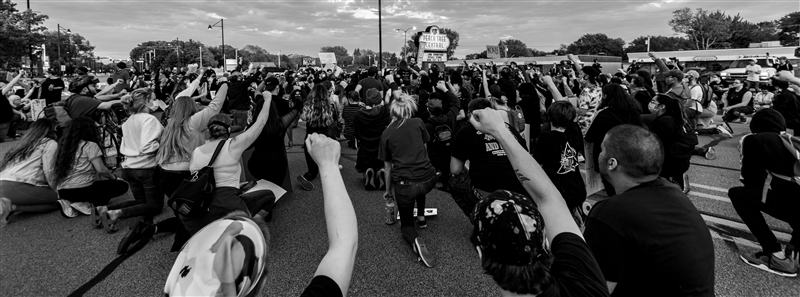
2. Why Does the Public Care about the Past (If It Cares at All)?
Summary: The great majority of survey respondents indicated interest in history for reasons transcending classroom requirements. In fact, formal education held little attraction as a motivator to learn about the past. Meanwhile, a nontrivial proportion of respondents voiced no interest at all in learning history. In all cases, cross-tabulations expose differences as a function of age, education level, gender, race/ethnicity, and political affiliation.
There are obviously many reasons why people take interest in history. These interests can be deeply self-serving or altruistic, conscious or subconscious, voluntary or compulsory, to list just a few competing possibilities. We attempted to tease out such motives by asking respondents to select from five possible reasons for learning about the past, the topline results of which are shown in Figure 8.
 Figure 8: Survey respondents’ reasons for wanting to learn more about events in the past. (S6)
Figure 8: Survey respondents’ reasons for wanting to learn more about events in the past. (S6)
The plurality response of simply wanting to be more informed about the past should not be surprising, given the public’s emphasis on factual matters as the very essence of history (Figure 1). Whether this is learning for learning’s sake, and how respondents see themselves using this information (or not), are matters for further study. A close second choice of learning history for its entertainment value is consistent with where people get their historical information, which is the subject of this study’s next section. Nearly a fifth of responses implied putting knowledge of the past to use, in this case as information and stories to share with children. Once again, is this for educational or entertainment value? Or trying to ensure a legacy, passed down through generations? One can only speculate. An especially weak motive for learning history was an educational requirement to do so. (This is discussed in more detail in later sections on the public’s classroom experiences and how people want to learn about the past.)
Perhaps the most sobering finding from this survey question is that 8 percent of respondents voiced no interest at all in learning history. It is possible this cohort equated “learning history” with classroom study, which, as discussed, held little attraction. But it is certainly possible that these responses should be taken at face value, much as people have aversions to other areas of inquiry and human experiences.
It is worth examining this “no interest” response more closely by subgroups. Those reaching double-digit uninterest in history included people of color (10 percent), men of color (10 percent), those living in southern states (10 percent), people without a college degree (11 percent), Blacks (11 percent), women (11 percent), white women (11 percent), and those without any political party preference (15 percent). Those scoring lowest on this item (i.e., least likely to voice uninterest in learning history) were men (7 percent), Democrats and independents (7 percent), respondents in western states (7 percent), people over the age of 65 (6 percent), white men (5 percent), and those with a college degree (4 percent).
Instances where demographic groups differed by at least 10 percent on particular motives included college versus non–college graduates (Figure 9; namely to be more informed as a motive), race (Figure 10; importance of sharing history with children), race and ethnicity (Figure 11; multiple motives), race/ethnicity/gender (Figure 12; multiple motives), and political party affiliation (Figure 13; to be more informed).
 Figure 9: By education level: Respondents’ reasons for wanting to learn more about events in the past. (S6)
Figure 9: By education level: Respondents’ reasons for wanting to learn more about events in the past. (S6)
 Figure 10: By race: Respondents’ reasons for wanting to learn more about events in the past. (S6)
Figure 10: By race: Respondents’ reasons for wanting to learn more about events in the past. (S6)
 Figure 11: By race/ethnicity: Respondents’ reasons for wanting to learn more about events in the past. *Fewer than 100 responses. (S6)
Figure 11: By race/ethnicity: Respondents’ reasons for wanting to learn more about events in the past. *Fewer than 100 responses. (S6)
 Figure 12: By race/ethnicity/gender: Respondents’ reasons for wanting to learn more about events in the past. (S6)
Figure 12: By race/ethnicity/gender: Respondents’ reasons for wanting to learn more about events in the past. (S6)
 Figure 13: By political party: Respondents’ reasons for wanting to learn more about events in the past. (S6)
Figure 13: By political party: Respondents’ reasons for wanting to learn more about events in the past. (S6)
Challenges and opportunities: The fact that 8 percent of the public sees no value in learning about the past is alarming, especially since that number tilts more heavily toward people of color and those without college degrees. Still, that figure must be balanced against the 91 percent of respondents whose motives for learning history appear to be intrinsic. School seems to be a weak motivator to become better acquainted with the past, but respondents with college degrees were considerably less likely to dismiss the discipline altogether than were their nondegreed peers. In this sense, higher education appears to have a positive effect.
About the Survey

Download the report as a PDF and access its underlying survey data.
Acknowledgments
This project was made possible by the generous financial support of the National Endowment for the Humanities and a seed grant provided by the Office of the Provost at Fairleigh Dickinson University.


